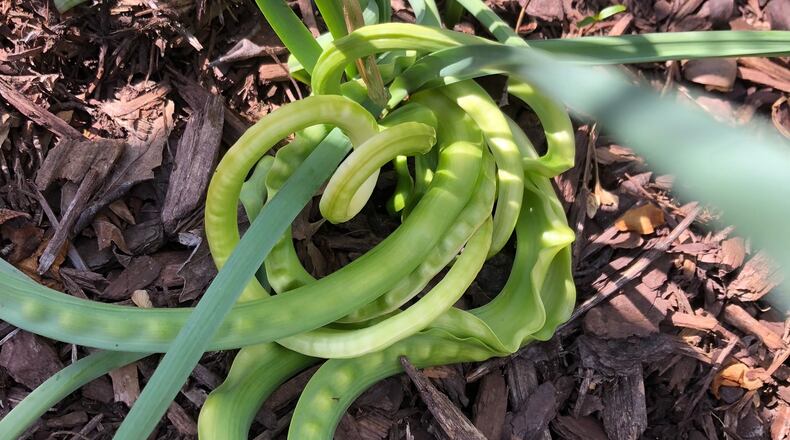Q: My daffodil leaves are curling round and round; they are not growing straight. Can you tell me what’s wrong? Lisa Henry, email
A: Curling leaves on daffodils can happen when they are sprayed with 2,4-D, a common broadleaf weed killer. The chemical is a hormone that affects plant growth. It makes cells reproduce abnormally and causes cupping and rolling of leaves. I think that is what caused the odd leaves. Daffodils are pretty tough. It’s possible yours will survive.
Q: I ordered an Okame flowering cherry online. The tree I received was basically a whip: It was 5 feet tall with only one branch. How do I prune this whip to help it develop a good branch structure? Hilda Brucker, Doraville
A: It’s easy to prune flowering cherries. You do it like a peach tree, trying to achieve an open center. If the whip is taller than 36 inches, cut it around the 36-inch mark, trying to make the cut above a nice bud. If it is shorter than 36 inches, just clip off the top bud. In a few months, you should have three or four little branches coming out near the top. Ideally, looking from above, they should go out in equal arcs. If one is not pointing the way you want it to, use stiff wire to make a spreader to make it grow the way you intend. When the new sprouts are 10 inches long, clip each tip to make them rebranch further. Allow the limbs to grow outward and upward, wait a few years, and you should have a nice tree!
Q: I have a sinkhole in my front lawn. It is 12 feet long, 6 feet wide, and 1 foot deep. What is the best way to deal with this? Ken Luangruangrong, Alpharetta
A: If the grass is healthy, you can remove it in strips that have at least 1 inch of soil on the roots. Store the strips in a shady place until you repair the sinkhole. Inspect it carefully to determine if the problem was caused by buried debris that has decayed. Use a long rod to probe the sinkhole to determine how deep and wide the hole actually is. Look for traces of decayed trees or building materials. A sinkhole as big as you describe will probably require a professional to fix it. If you want to do it yourself, call 811 before digging to make sure there are no buried utility lines. Dig the entire sunken area down and out to undisturbed earth. When the cavity is empty, add loose fill dirt in 10-inch layers. Pack the soil firmly after each 10-inch layer to prevent future settling. Failure to pack the entire cavity will cause another sinkhole in the future. Once the cavity is almost full, you can plant your saved grass on the spot.
Email Walter at georgiagardener@yahoo.com. Listen to his occasional garden comments on “Green and Growing with Ashley Frasca” Saturday mornings on 95.5 WSB. Visit his website, www.walterreeves.com, or join his Facebook Page at bit.ly/georgiagardener, for his latest tips.
About the Author
The Latest
Featured

